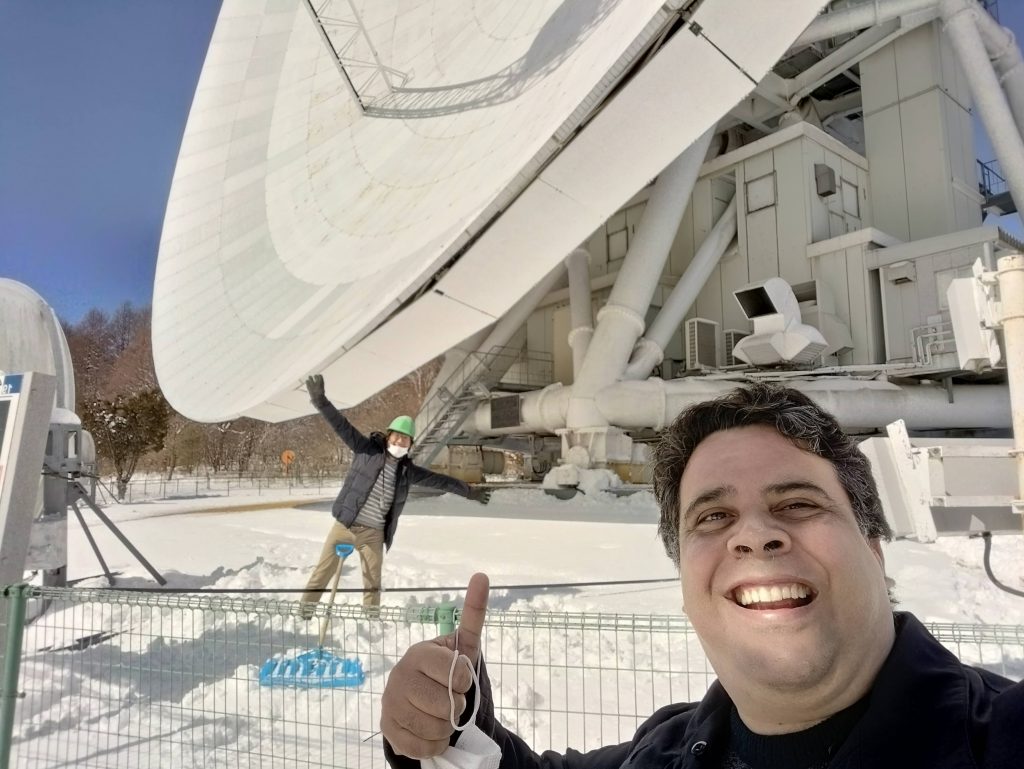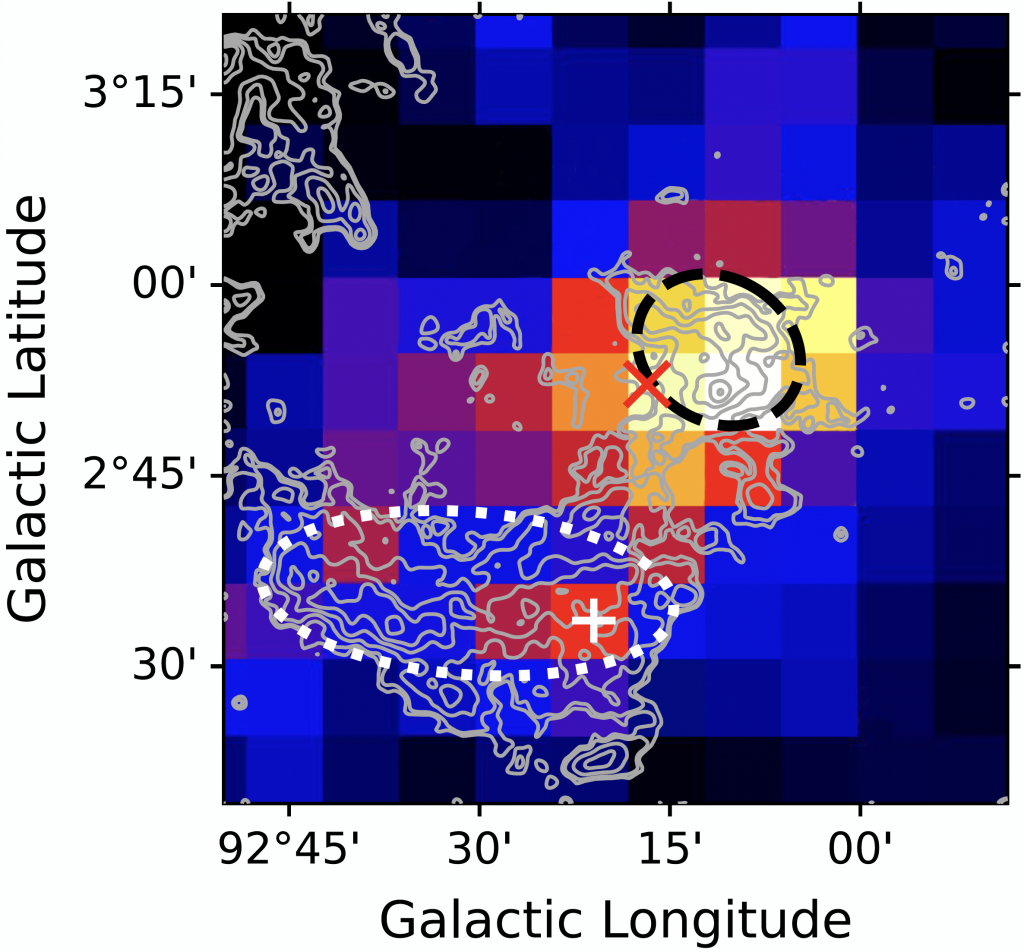Combined observations of high-energy gamma rays and radio signals targeting LHAASO J2108+5157—discovered by China’s LHAASO experiment in the Cygnus OB7 region—are drawing significant attention. A research initiative led by Specially Appointed Professor Eduardo De La Fuente (Professor at the University of Guadalajara and collaborator on the ALPACA experiment) has used radio telescopes to reveal the presence of two dense molecular clouds.
These findings point to two intriguing possibilities: the observed 100 TeV gamma rays may have resulted from collisions between cosmic ray protons and the molecular clouds, and a nearby PeVatron may be emitting cosmic rays in the PeV energy range. This source is particularly unusual, as it eludes detection at energies below 100 TeV, and no known objects in the vicinity have been identified as potential sources of PeV-range cosmic rays.
We spoke with Professor De La Fuente to learn more about his research insights and the mysteries he’s working to unravel through radio astronomy.

◇What inspired you to pursue radio telescope observations at both Osaka Prefecture University and the Nobeyama Radio Observatory?
It was very exciting (kakoi, waku-waku). To explore the nature of some astronomical objects called “PeVatrons”, a hot topic in high energy astrophysics in this decade of the 2020s, one needs to combine gamma-ray and cosmic ray astrophysics with radio astronomy. In my PhD thesis I worked on radio astronomy and since 2007 I have been working on cosmic and gamma-ray astronomy at the “High Altitude Water Cherenkov (HAWC) Observatory in Mexico.
When I took my sabbatical here at ICRR in 2021, I talked to my colleagues from ICRR’s ALPACA group to share with them an idea that came up here in Japan when I was walking to ICRR from Kashiwanoha station: to study PeVatrons in the Cygnus region of the sky with Japanese radio telescopes in the Nobeyama highlands in Nagano. The first contact was with colleagues from “Osaka Prefecture University (OPU, Current: Osaka Metropolitan University)” to use observation data from their 1.85-meter radio telescope.
The idea was successful and was published in 2023 in the journal “Publications of the Astronomical Society of Japan”, in which several Mexican and Japanese colleagues were involved:
https://doi.org/10.1093/pasj/psad018
In astronomy, the ability to detect something is called “sensitivity”, and the ability to study spatially details is called “resolution”. It is very important to combine both aspects in one study. Therefore, the next step of our Mexican-Japanese effort was to study at higher resolution the objects in Cygnus that we studied with 1.85-meter radio telescope.
The best Japanese radio telescope for this purpose and one of the most powerful telescopes of its kind is the 45m Nobeyama radio telescope, which can be seen in the movie “Detective Conan: One-Eyed Flashback”. My colleague from ICRR, Kazumasa Kawata, contacted people from Nobeyama Radio Observatory (NRO) and considering the success after using OPU, we got the observation time to study our objects with the 45m radio telescope and I said:
Ehhh, we are going to use the 45-meter radio telescope in Nobeyama to study the Pevatron. That is exciting.
With these observations, we published another article in the journal Astronomy and Astrophysics as a letter:
https://doi.org/10.1051/0004-6361/202346681
Based on this project, which was born in ICRR-UTokyo and involves Mexican
and Japanese researchers in an international collaboration, Nobeyama’s radio telescopes are playing a fundamental role in the realm of PeVatrons.

◇What conclusions and implications did you draw from your survey of LHAASO J2108+5157?
The study of PeVatrons is very important for the study of cosmic rays in the Universe, especially for the identification of the cosmic accelerators (at high energies: Tera eV to Peta eV range) that produce them. In addition, the PeVatrons can help answer the question through their observations: What is the highest energy at which nature can accelerate particles? So far, the answer lies in the range of Peta electron volts (PeV energies).
PeVatrons are astronomical sources, cosmic accelerators that accelerate particles to the highest energies in our Galaxy. The most powerful accelerators on Earth, such as the LHC at CERN, only reach a few tera-electron volts (TeV), so PeVatrons are natural particle accelerators whose nature needs to be understood. Roughly speaking, we refer to gamma-ray emission due to electrons as “leptonic” emission and protons (hydrogen) mainly, as hadronic emission.
Since its discovery in 2021, the PeVatron candidate LHAASO J2108+5157 has been one of the most enigmatic sources in the original list of 12 sources, as it is the only one with no counterpart at other energies to explain the observed gamma-ray emission. It is located in one of the Cygnus regions that we initially studied with the OPU radio telescope and later with the Nobeyama 45m Single Dish.
With radio telescopes it is possible to determine how many hydrogens (protons or nucleons) per cubic centimeter — the volumetric density — are present at a zone. With the Nobeyama radio telescopes, we can realistically determine the density of nucleons in LHAASO J2108+5157.
This measurement is very important to constrain the observed gamma-ray emission (leptonic or hadronic) by analyzing the hadronic component.
Thus, we study one of the most enigmatic PeVatrons in the Universe, not only because we provide for the first time a better estimate of the volumetric density, but also because, given the lack of sources associated with leptonic origin so far, we favor the hadronic nature of the source associated with the molecular gas observed by radio telescopes.
The latter note the high synergy available to science when we combine data from gamma and/or cosmic ray observatories like ALPACA and CTA in future, with radio telescopes.
If the absence of leptonic emission is confirmed in the future, LHAASO J2108+5157 could be one of the iconic or even eponymous hadronic PeVatrons, as the hadronic component has already been confirmed with Nobeyama.

◇What was your specific contribution to the survey that you think should be highlighted?
Determining the density of nucleons in a realistic way by first time, discard some suggested PeVatron counterparts in this enigmatic object, and look for others, especially those that could be hadronic in nature.
◇I heard that the collaboration is currently working on another paper. Could you share what kind of results you are preparing to publish?
In our article in the Astronomy and Astrophysics Letter, we published data that we observed with the Nobeyama 45-meter radio telescope in the southern region of the molecular gas of LHAASO J2108+5157. In this new publication, we will report new observations in the northern region, which together with the southern region yield a pioneer whole map of the molecular gas of LHAASO J2108 with the highest resolution to date. Furthermore, we try to explain our results with the conjecture that a supernova remnant interacts with molecular gas and causes gamma-ray emission.
◇Do you have any future plans for research on this topic?
Yes, I have. With LHAASO J2108+5157 is about: 1. continuing the search and the PeVatron counterpart or source that produces the gamma rays, 2.- to contribute to the study of the leptonic nature of gamma rays, and 3. continuing to study the molecular gas at the highest densities.
As part of the PeVatrons theme, it will study other PeVatrons candidates combining radio telescopes such as those at Nobeyama and the third-generation gamma-ray observatories such as ALPACA.

Profile:
Prof. Eduardo De La Fuente Acosta
He is an International Mexican physicist serving as a full-time faculty member at the Departamento de Fisica, CUCEI, of the Universidad de Guadalajara (UdeG). His areas of expertise include high-energy physics, astrophysics, astroparticle physics, and the search for PeVatrons. Since 2003, he has been involved in teaching and academic administration in the fields of natural sciences and engineering.
He earned his Bs. Sc. and Ph.D. degrees in physics from UdeG, and obtained a Master’s degree in astronomy from the Instituto de Astronomía of the Universidad Nacional Autónoma de México (UNAM). During his doctoral studies, he conducted research at the Instituto de Radioastronomia y Astrofisica of the UNAM, and after completing his Ph.D., he worked as a postdoctoral researcher at the Instituto Nacional de Astrofísica, Óptica, y Electrónica (INAOE). In 2023, he also completed a Master’s program in International Higher Education at CUCEA, UdeG.
Internationally, he spent a sabbatical year in 2021 at the Institute for Cosmic Ray Research (ICRR), University of Tokyo, where he participated as Mexico’s co-representative in the ALPACA and Hyper-Kamiokande experiments. In 2025, he was invited to ICRR as a project professor. Since 2007, he has also been a collaborator in the international High Altitude Water Cherenkov (HAWC) Observatory in Mexico. As of 2024, he has published approximately 130 peer-reviewed papers, with over 9,400 citations and an H-index of 38. He has actively participated in numerous international academic conferences and has supervised students at the undergraduate, master’s, and doctoral levels.





